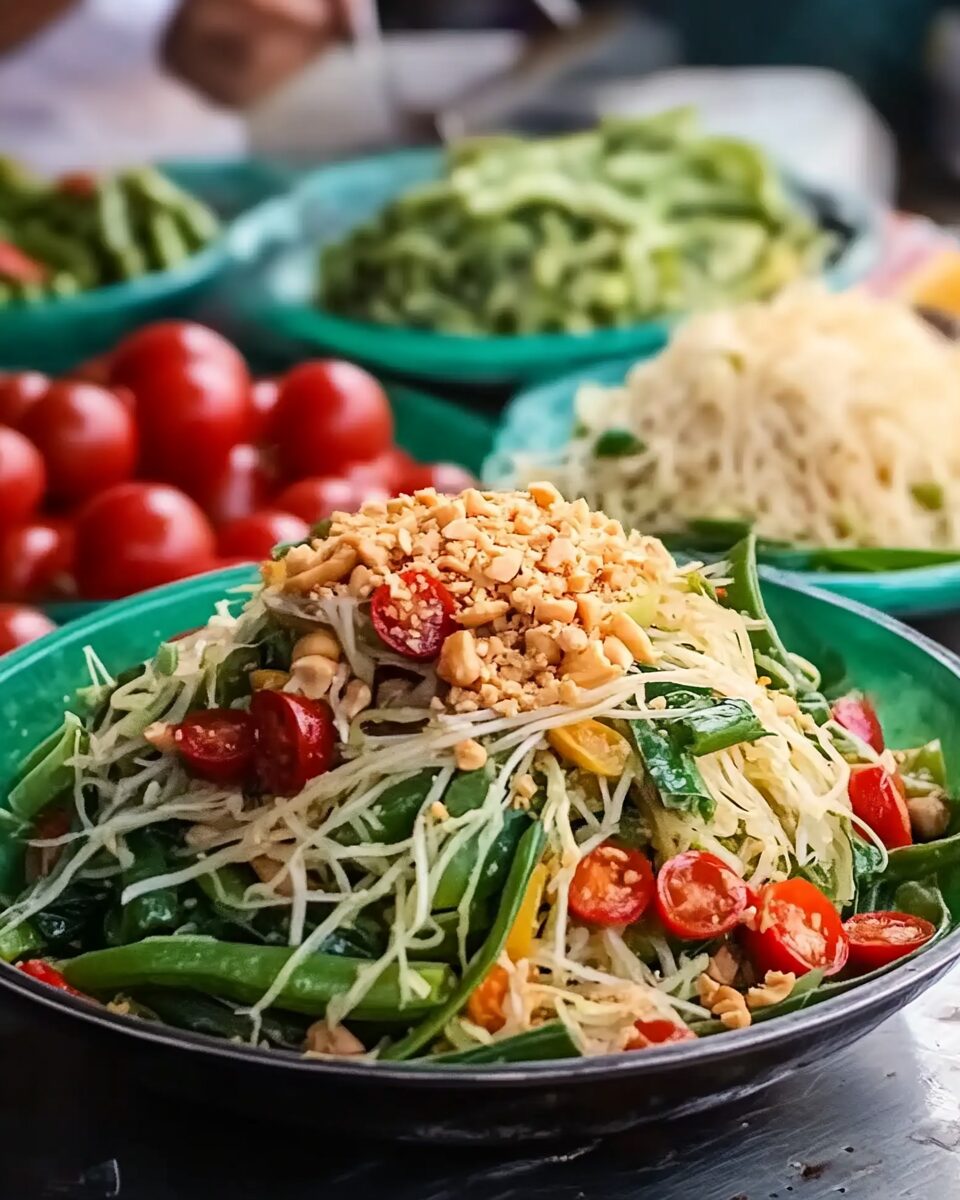Why Green Papaya Salad is So Loved
One of the key reasons Som Tum is beloved across cultures is its unique flavor balance. It captures the heart of Thai cooking’s four essential tastes—sweet, salty, sour, and spicy—all in perfect harmony. The zing from fresh lime juice, the pungent depth from fish sauce, the caramelized richness of palm sugar, and the fiery bite of bird’s eye chilies all unite in a single dish that feels refreshing yet deeply savory.
The versatility of the dish also contributes to its popularity. While the classic version uses dried shrimp for umami depth, modern interpretations cater to vegetarian and vegan preferences by omitting or substituting this ingredient. Its freshness and lack of heavy oils or fats make it an ideal choice for those seeking light, nourishing meals without compromising on taste.
Furthermore, Green Papaya Salad has a strong presence in global food culture. It was named one of the world’s top 50 best foods by CNN Travel, which helped boost its international profile. Its popularity has grown not just in Southeast Asia but across the globe, with Thai restaurants in nearly every major city offering their take on Som Tum.
Health Benefits of Green Papaya Salad
Som Tum is a health-conscious choice packed with essential nutrients. Green papaya is the star ingredient and is rich in digestive enzymes such as papain, which aids in breaking down protein and easing digestion. It’s also a great source of vitamin C, providing immune-boosting benefits while promoting skin health and collagen production.
Snake beans, another component of the salad, are rich in fiber and plant-based protein, contributing to gut health and sustained energy. The tomatoes offer a healthy dose of lycopene, a powerful antioxidant known to combat inflammation and support heart health.
Despite the salty flavor from fish sauce, the overall fat content in this dish is relatively low. Roasted peanuts add healthy monounsaturated fats and protein, making it a filling option for those monitoring their weight or following a heart-healthy diet. The combination of raw vegetables and herbs also ensures that the dish is low in calories yet high in micronutrients.
For those following a gluten-free diet, Som Tum is naturally compliant, as none of the ingredients contain gluten. It’s also adaptable for paleo or keto diets with a few simple modifications to the dressing.
Cultural Significance and Origins
The cultural roots of Green Papaya Salad run deep in Thailand’s history. In rural communities, especially in Isaan, the pounding of ingredients in a mortar is a daily ritual. Food isn’t just nourishment—it’s a way to gather, communicate, and share. This tradition is passed down through generations, and even today, many Thai homes and street vendors uphold the original method of preparing Som Tum by hand.
In Thailand, Som Tum is often eaten with sticky rice and grilled meats, forming a staple part of lunch or dinner. It’s not uncommon to find regional variations too, with some recipes including salted crab, fermented fish sauce (pla ra), or even small local fruits. This reflects the resourcefulness of Thai cuisine—using what’s fresh and available, yet making it memorable.
Som Tum is also widely sold by street vendors and in local markets, often customized on the spot to suit a customer’s spice level or ingredient preference. This communal, made-to-order aspect is part of the charm that makes it feel personal and satisfying.
Serving Suggestions and Pairings
Green Papaya Salad is best served freshly tossed and chilled, maintaining its vibrant crunch. It pairs wonderfully with sticky rice, which helps to mellow the heat and balance the acidity. Another traditional companion is grilled chicken or pork, adding smoky richness that complements the salad’s freshness.
For a vegetarian meal, serve it with jasmine rice and grilled tofu or tempeh. It also shines on a shared platter as part of a Thai-inspired spread alongside spring rolls, satay skewers, and a coconut milk-based soup like Tom Kha Gai.
Drinks like iced Thai tea or a cold, lightly sweetened lemongrass drink balance the spicy and tangy notes of the dish. Even a glass of Riesling or dry rosé can be a delightful wine pairing if you’re turning it into a dinner party appetizer.
Tips for Perfecting the Recipe
To ensure the best texture and flavor, it’s important to use freshly shredded green papaya, not the ripened version. Green papaya is firm and holds its crunch even after mixing. A julienne peeler or mandoline can help achieve the ideal thin matchsticks for this dish.
When pounding the ingredients for the dressing, it’s important not to over-process them into a fine paste. You want to keep a bit of chunkiness to maintain texture and allow each ingredient to shine. Gently bruising the tomatoes and snake beans helps them soak up the dressing and adds dimension to the flavor.
Adjusting the spice level is key depending on your preference or guests’ tolerance. Bird’s eye chilies are small but mighty—start with fewer if unsure, and always wear gloves when handling them to avoid irritation.
Lastly, always taste and balance the dressing before tossing in the papaya. Thai cooking thrives on balance, so you may need to tweak the lime juice, fish sauce, or sugar to achieve the perfect harmony for your palate.
Conclusion
Green Papaya Salad, or Som Tum, is a dish that offers more than meets the eye. Behind its bold and refreshing flavors lies a culinary tradition steeped in history, health, and heartfelt simplicity. Its ability to balance taste, nourish the body, and adapt to various diets makes it a timeless favorite in both Thai kitchens and global homes. Whether enjoyed on a bustling Thai street or recreated at home, Som Tum captures the essence of vibrant, flavorful, and healthy eating in every bite. For food lovers seeking a salad that excites the senses and tells a story, this dish is an unforgettable journey through Thailand’s rich culinary heritage.






